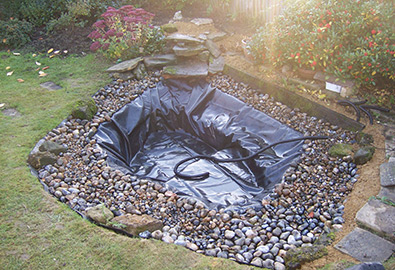How to drain your pond
s your pond looking a bit overgrown or murky? It may be time to drain your pond to give it a proper clean. At first, draining a pond may seem like a daunting task, but with the right approach, it’s actually fairly simple.
In this guide, we’ll walk you through the steps to drain your pond with or without a pump, so you can get your water garden up and running again.
When should I drain my pond?
Over time, your pond water can become home to all sorts of bacteria, debris, and sediment, which can lead to poor water quality and an unattractive appearance. You may also need to drain your pond in between seasons, such as setting up for summer or winter.
Here are some signs that you may need to drain your pond:
- Algae growth: If you notice an increase in algae blooms that persists despite regular cleaning, draining the pond can reset the ecosystem.
- Poor water clarity: If the water appears green, murky or has a foul smell, it’s an indication that the pond may be harbouring harmful bacteria or decomposing organic matter. Draining can help restore clarity and freshness to the water.
- Debris: Over time, leaves, and other debris can accumulate at the bottom of your pond. If you notice a significant build-up, and cannot remove it, draining the pond may be necessary to clear out any unwanted materials.
- Damage to pond liner: If you notice leaks in your pond, there could be tears or damage to your pond liner, and draining the pond is essential for repairs.
You may also want to make changes to your pond’s size and landscape. In this case, you’ll need to fully remove the water to make adjustments.
How to drain your pond with a pump
The easiest way to drain your pond is by using a submersible pump or pond vacuum to remove the water. Make sure to remove any fish before you begin draining.
You can drain the pond in a few steps:
Start cleaning your pond surfaces, including the sides and bottom, to remove any algae or sludge that may be present.uch dye into the water. The dye will disperse quickly and should not harm any fish or plants in your pond.
Submerge the pump in the deepest part of the pond, so that it’s fully underwater.
Run the pump’s hose to a designated drainage area such as a bucket or a nearby garden. Ensure that the area can handle the volume of water being drained before you start. For small ponds, you could just empty into your garden.
Turn on the pump and let it do its work! Monitor the process to ensure that the water is draining properly and that there aren’t any leaks in the hose.
Once the water level has dropped significantly, use a net to remove any remaining debris from the bottom of the pond.
How to drain your pond without a pump
Don’t worry if you don’t have a pump, you can still drain your pond using gravity or a siphoning method. This isn’t always an option for larger ponds, but it can work well for smaller ones. You can use any kind of hose or tubing for this method, but a manual hand pump is often best. Here’s how to do it:
Continue to monitor the water level as it drains. You may need to reposition the hose to ensure that it continues to siphon.
Position the outflow hose below the deepest point of your pond.
Position the other end of the hose in the drainage area, much like when using a pump.
Once submerged, quickly remove the end from the water while keeping your hand over it, allowing gravity to pull water through once you place it in the drainage area. This creates a siphon effect.
Refilling your pond
When you remove the water, you’re also removing some beneficial bacteria needed to keep your pond balanced. While the bad bacteria is removed, it’s important to reintroduce beneficial bacteria as soon as the pond is refilled. You can add a dechlorinator to the water to avoid harming any fish you plan to reintroduce later.
If you’re using tap water or from a hose you’ll need to add a water softener such as our Wildlife Pond Tap Safe. This will naturally remove any toxic chemicals in tap water making it safe for fish and pond life. You can always use a test kit to make sure your pond water is balanced before reintroducing your fish.

